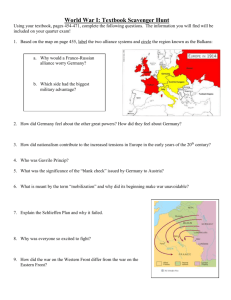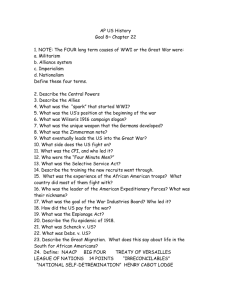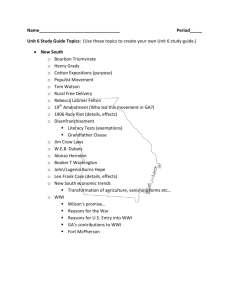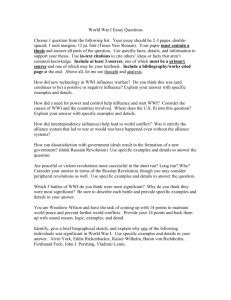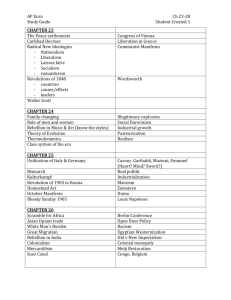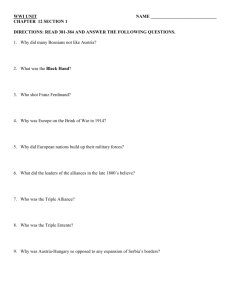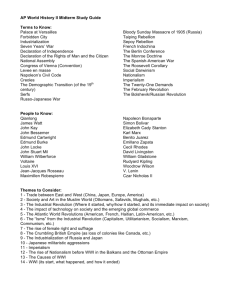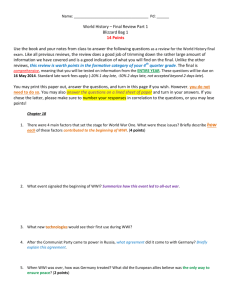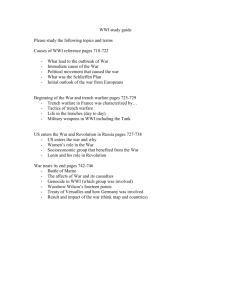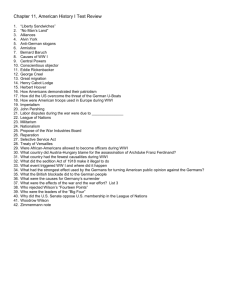rg11 - Hinsdale Central High School
advertisement
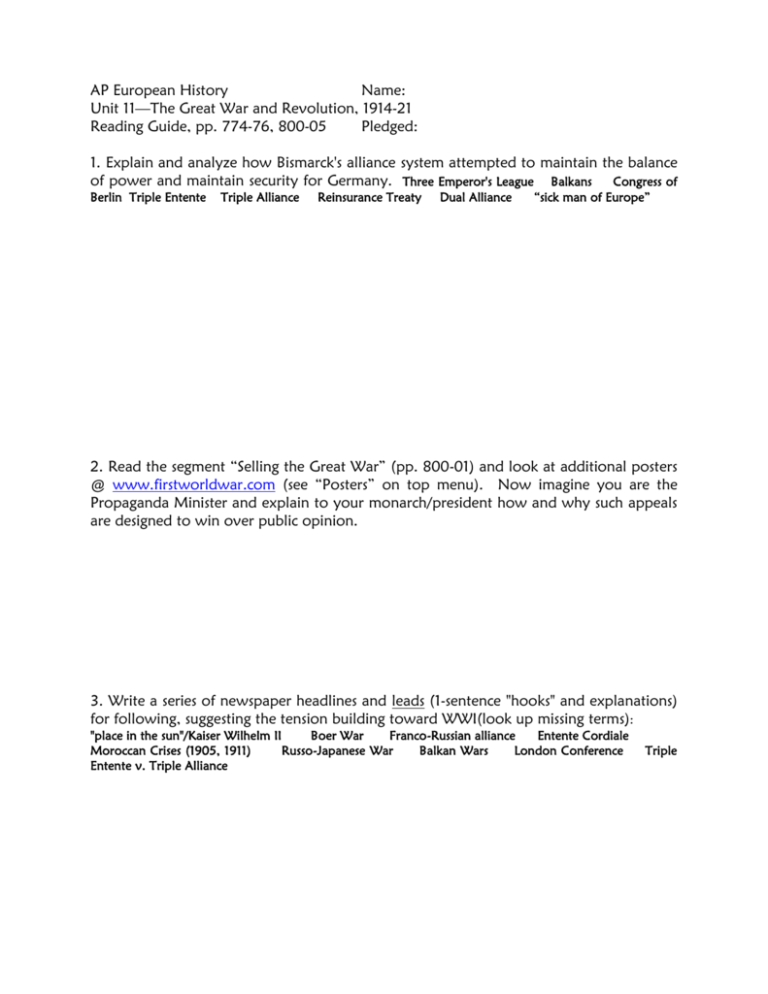
AP European History Name: Unit 11—The Great War and Revolution, 1914-21 Reading Guide, pp. 774-76, 800-05 Pledged: 1. Explain and analyze how Bismarck's alliance system attempted to maintain the balance of power and maintain security for Germany. Three Emperor's League Balkans Congress of Berlin Triple Entente Triple Alliance Reinsurance Treaty Dual Alliance “sick man of Europe” 2. Read the segment “Selling the Great War” (pp. 800-01) and look at additional posters @ www.firstworldwar.com (see “Posters” on top menu). Now imagine you are the Propaganda Minister and explain to your monarch/president how and why such appeals are designed to win over public opinion. 3. Write a series of newspaper headlines and leads (1-sentence "hooks" and explanations) for following, suggesting the tension building toward WWI(look up missing terms): "place in the sun"/Kaiser Wilhelm II Boer War Franco-Russian alliance Entente Cordiale Moroccan Crises (1905, 1911) Russo-Japanese War Balkan Wars London Conference Entente v. Triple Alliance Triple 4. List 4-5 attitudes that Europeans had about the world and diplomacy on the eve of WWI. a. b. c. d. e. 5. The assassination of Franz Ferdinand (heir to the Austrian throne) set off the spark of the Balkan powder keg. Draw a fairly detailed diagram that shows how these causes interacted and were ignited by the assassination. 6. Look at the map on p. 804. How do you think war plans—Schlieffen and Plan XVII— guided the decision-making of European leaders? AP European History Name: Unit 11—The Great War and Revolution, 1914-21 Reading Guide, pp. 806-14, 823-25 Pledged: 1. Fill out the chart below on the phases of WWI, using and underlining/highlighting terms. Phase Objs./Strategies Leaders Battles Results 1914: War of Illusion 1915: Stalemate 1916-17: Great Slaughter 1917-18: End The Schlieffen Plan Plan XVII Battle of Marne Tannenberg/Masurian Lakes Ypres Hindenburg Ludendorff Lemberg Somme Verdun/ Falkenhayn Joffre Gallipoli Lawrence of Arabia Jutland Italy U.S. Lusitania Brusilov Offensive unrestricted submarine warfare D. Haig H. Petain Passchendaele offensive F. Foch Nivelle offensive Russian Revolution AEF/Pershing armistice 2. Use ONE specific piece of information from the document (p. 813), map (p. 810), and pictures (pp. 806,808, 812-13) to show how WWI was the first total war. document map pictures total war: 3. Using the document on p. 807, Web document on p. 806, and poem on p. 809, analyze the psychological impact of WWI on Europe and contrast the nature of the war with expectations prior to its outbreak. 4. List 10-12 technological and tactical developments that account for the high casualty and death rates of WWI. Then provide a 2-3 sentence analysis of the nature of the war. analysis: 5. Write a brief poem about life in the trenches during WWI. smarminess. Avoid clichés and AP European History Name: Unit 11—The Great War and Revolution, 1914-21 Reading Guide, pp. 814-17 Pledged: 1. Imagine you are an advisor to Franz Joseph I (Austrian Emperor). Write him a memo on the need for significant government efforts to mobilize for the war. Use examples from other nations to indicate the kind of actions needed. Walter Rathenau War Raw Materials Board rationing blockade Lloyd George G. Clemenceau Ludendorff/Hindenburg Ministry of Munitions David 2. prompt (write a thesis with evidence): Analyze the impact of total war on the relationship of the state to the economy and society. 4. opinion: Should governments place limits on speech and opposition during wartime? Use examples: Easter Rebellion strikes Defense of the Realm Act (DORA)--look up censorship propaganda Hindenburg Ludendorff 4. Make a balance sheet of how the war affected each group. We’ll finish parts in class. Group * labor --skilled Pros Cons --unskilled * women * industrialists * middle class 5. Using the document on p. 815 and text discussion, explain how and why the First World War had a democratizing effect on society. AP European History Name: Unit 11—The Great War and Revolution, 1914-21 Reading Guide, pp. 825-28 Pledged: 1. Write a brief dialogue between Clemenceau and Wilson that brings into relief their contrasting views on Europe’s postwar order. Fourteen Points 2. List and briefly explain 5-6 main provisions of the Treaty of Versailles and related treaties. W. Wilson/Fourteen Pts. D.L. George Clause) reparations demilitarization Balfour Declaration a. b. c. d. e. f. G. Clemenceau League of Nations Article 231 (War Guilt new states mandates self-determination Middle East 4. Draw in the territorial changes made in 1919-24 and write a sentence on how the "peace" affected any of the key nations and/or regions. 4. Some historians believe that the Versailles settlement was too harsh and set the stage for totalitarian movements in the 1920s/30s and ultimately the Second World War. Do you agree or disagree with this assessment? Why or why not? 5. "When I heard the news of the armistice I went out walking along the dyke above the marshes at Rhuddlan, cursing and sobbing and thinking of the dead..." Look again at the pictures in this chapter, consider the excerpt from Robert Graves above, and then write a 1-sentence reflection on the significance and meaning of WWI. AP European History Name: Unit 11—The Great War and Revolution, 1914-21 Reading Guide, pp. 817-23 Pledged: 1. Assess the relative importance of long-term causes (1860-1914) with the impact of WWI in bringing about the end of the 300-year-old Romanov Dynasty. Rasputin 2. Devise a slogan and explain it for each of the contending groups below (look up missing): Constitutional Democrats (Kadets)-Social Revolutionaries (SRs)-Mensheviks-Bolsheviks-4. Briefly explain the importance of each term in the chronology of the Russian Revolution (look up missing terms). Note: Russia did not adopt the Gregorian calendar until 1918 and was "behind" by 13 days. Feb. Revolution-- Int'l Womens Day-- Provisional Gov't-- soviets-- "vanguard party"-- "April Theses"-- "peace, bread, land"/ "all power to soviets"-- Army Order No. 1-- Alexander Kerensky-- Lvar Kornilov-- Leon Trotsky-- Bolshevik (Oct.) Rev.-- all-Russian Cong. of Soviets-- Council of People's Commissars-- Constituent Assembly-- Treaty of Brest-Litovsk-- 4. Based on “A Closer Look,” make a Venn diagram that shows 3 similarities and 3 differences between the involvement of women in the French and Russian Revolutions. 5. puzzler?--How did the Bolsheviks, outnumbered and with minimal popular support, defeat their enemies in the Russian Civil War (look up terms)? Red Army Cheka "war communism" Whites 6. counter-factual hypothesis: Suppose that Alexander Kerensky had withstood the Bolshevik challenge, saved Russia a humiliating defeat in WWI, and established a functioning republic with a strong executive. Explain how the 20th century would have turned out differently.
